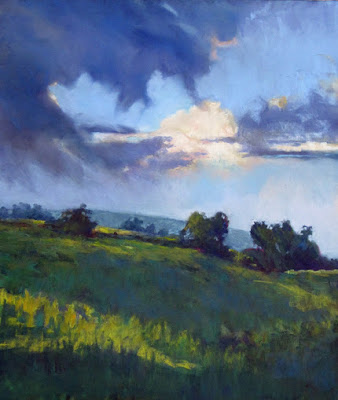Great art doesn’t spring fully-formed from the minds of geniuses. It is made incrementally.
Art & Fear by David Bayles and Ted Orland is a book I frequently recommend to students. The title is misleading because it’s less about the insecurities that stalk the artist and more about the reiterative, plodding process that produces great art. If the book does anything, it shreds the Cult of Genius that has dogged the art world since the Enlightenment.
Among the silliest distinctions in the world of art is that between so-called ‘fine art’ and ‘fine craft.’ Prior to the Age of Enlightenment, artists were craftsmen. It was only with the Romanticism that artists developed the slight stink of intellectualism.
| Dish of Butter, by Carol L. Douglas. 6X8, oil on canvas, $348 unframed. |
Art & Fear comes down firmly on the side of craft. Art gets made by ordinary people like you and me, who work at our craft regularly. We chip away at a problem, and we master it, and we are content… until our minds throw up a new problem. We then repeat the process, and somehow, in all that indefinable chaos, there’s progress.
Nevertheless, there is fear in the art process. I was first introduced to this concept at the Art Students League, where my instructor gleefully announced to her new students, “You’re all terrified!” I’m naturally pugnacious, so my reaction was to deny that, loudly. It’s taken a long time for me to realize that some of my stalling mechanisms are, indeed, fear at work.
| Back it up, by Carol L. Douglas. 6X8, oil on canvas, $348 unframed. Still life does not have to be about elegant old dishware. |
Fear is one reason artists have studios full of unfinished work. We can either leave it in this state, where it has potential, or finish it so that all its shortcomings are revealed.
A healthy respect for the process can be a good thing, when it stops us from charging in and making stupid mistakes. When I was much younger, I did a surrealistic dreamscape of young mother on a broken-down farm. I was stumped trying to marry my currently-realistic style with the theme. I made the mistake of consulting a professional for a critique. “It looks like an imitation Chagall,” she said. I went home and covered it in a froth of bad paint. When I came to my senses, the original painting was irretrievable.
But fear can quickly become corrosive. I see it when new students are unable to engage in the exercises that I set in front of them, or constantly answer every suggestion with, “yes, but…”
| Tin Foil Hat, by Carol L. Douglas. 6X8, oil on canvas, $348 unframed. There was no point to this when I painted it, but it’s since become my self-portrait. |
It is not the beginners who have this difficulty, but people who have achieved some mastery of painting. They have a hard nut of competence that they hold tight against their hearts. To polish and shape it, they have to be able to hold it at arm’s length, but they can’t—they’re afraid that examining it will destroy something vital to their self-image.
I’m speaking as their soul-sister in this, by the way. It’s something that’s taken me a long time to get over.
Not that we ever really do get over our insecurity. Last week, Eric Jacobsen showed me a Charles Movalli painting he particularly admired. “That’s it! I quit,” I said. Of course, I’d said the same thing the week before that, and the week before that, too. In the face of great accomplishment, we are often momentarily cowed.
The difference—as Bayles and Ormond point out in their book—is that we sit back down at the easel and start again. And again. And again. That’s how great art happens.















